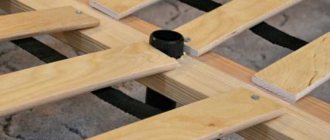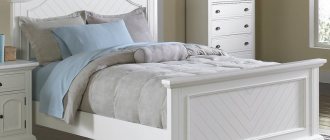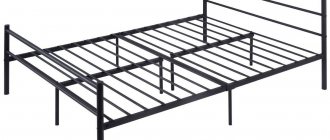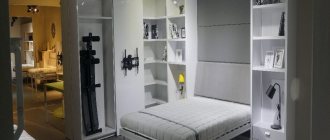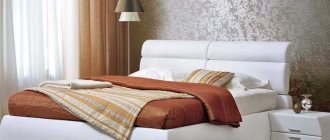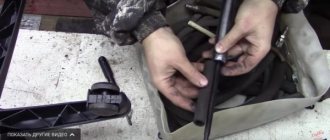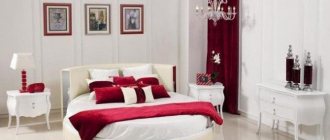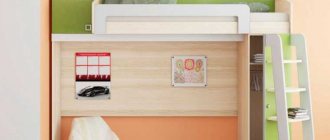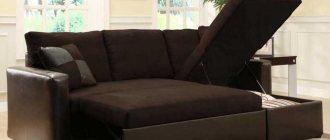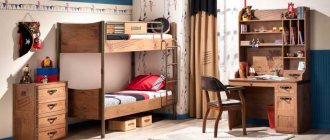95353
Any furniture wears out and becomes unusable. A wooden bed is no exception, even if it is made of high quality materials. After some time, you may notice that the bed is creaking, what should you do in this case to eliminate the unpleasant sound? First you need to establish the cause of the squeak, and only then take action.
The main causes of bed squeaking
What causes bed squeaking? Most often, creaking is a consequence of friction of wooden or metal elements, resulting from partial wear of the parts and components of the bed.
A quality bed is the key to a sound sleep!
Techniques for eliminating squeaks can be divided into three groups:
- strengthening of the structure due to additional fastenings;
- sealing joints with porous elastic materials;
- reduction of friction through the use of anti-friction lubricants.
Creaking can occur in various structural elements of the bed. Most often, creaking occurs in the following nodes:
- joints and places of fastening of bed frame elements made of natural wood or chipboard;
- bed base or frame with wooden slats;
- lifting mechanism;
- spring or polypropylene mattress.
Why might the bed squeak?
Methods for eliminating unpleasant sound vary for different bed components. An incorrectly chosen repair technology will not only be useless, but will also lead to further abrasion of materials and increased sound.
Video - Why does the bed squeak?
Prices for double beds
Double bed
Remove squeaks without disassembling the bed
The easiest way to eliminate the creaking of a wooden bed is to create a soft pad or strong support. You need to insert a soft object into the space between the headboard and the wall. Sometimes this helps soften the contact between two hard materials. On the free side, you need to support the foot with a chest of drawers or a heavy stand. This will help fix the furniture in the desired position and prevent its movement.
Such actions do not always help and do not last long. Therefore, to prevent the bed from creaking, you will have to use tools.
First, the fastening elements are tightly tightened using open-end or adjustable wrenches or screwdrivers. Most often, access to them is carried out without disassembling the furniture, but sometimes additional fastening in the form of metal corners and gluing joints may be necessary.
Do not neglect the intermediate method of coating in the connection of the frame, legs, headboard and foot. Even if it is not needed now, such processing will not be unnecessary.
It is necessary to consider how to get rid of bed squeaks if the cause is worn slats. First you need to swap the central and outer elements to relieve the stress on the tired wood. If this does not help, you will have to change the lamella.
How to determine the source of a squeak
To eliminate squeaking, it is important to understand which element of the bed needs repair or replacement. The sequence for determining the source of the squeak is given below.
Step 1. It is more convenient to examine the bed together. Sit down, lie down on the bed, get into a position where you can hear a creaking sound. At this time, the assistant can identify the problem area by ear.
Try to find the source of the squeak by ear.
Step 2: Rock the bed from side to side in all directions and also listen to where the sound is coming from.
Rock the bed from side to side
Step 3: Remove the mattress from the bed and place it on a flat floor.
Remove the mattress from the bed
Step 4. Try sitting and lying on the mattress, and also rock the bed without a mattress. By ear, try to determine which part of the bed is creaking.
Checking the mattress and frame separately
Step 5: If the bed frame and mattress do not squeak, the problem may be with the slatted base. The slatted base consists of wooden slats secured with lath holders to a frame made of metal or wood. Creaking usually appears at the place where the slats are attached. To check, inspect the slats and press each one with your hand.
Checking the slats
Step 6. If you find out that the problem is in the wooden frame, inspect all joints, check the tightness of the mounting screws or self-tapping screws. Fine wood dust, abrasions and chips on the surface of the wood will indicate wear of individual elements - they are usually the source of creaking.
Checking the reliability of frame fastenings
Step 7. A bed with legs may also creak at the joints between the frame and the legs. You can find out this by ear by rocking the bed with the mattress removed.
Attaching the leg to the bed
Step 8. For beds with a lifting mechanism, the source of squeaking is often the mechanism itself. As a rule, it cannot be repaired and requires replacement.
Bed with lifting mechanism
Advice! Before you start disassembling the bed and repairing it, make sure that it is the bed that is creaking, and not the floor underneath it!
Eliminating the creaking of a metal bed
A metal bed can also upset you with extraneous sounds, but eliminating squeaks is quite possible; the main thing is to correctly identify their source.
Special gaskets can be inserted between the rubbing parts of the metal bed frame
| Source of creaking | What to do |
| Loose mechanisms | Replace with conventional fasteners |
| Contacting surfaces | Wrap with plastic film |
| Armor mesh | Replacement or treatment with a special agent |
Experts say that there are not many options for repairing metal beds:
- Tightening fasteners at the connection of parts; In this case, special attention should be paid to the engraving washer, which should protect the nut from unwinding. In its absence, the joints weaken very quickly. If for some reason it is not there or it is broken, it must be installed, which will ensure the reliability of the fastener.
The bed fastenings need to be checked and tightened each of them - If the source of discomfort is the metal lattice (mesh), which is still found on old beds, you can try lubricating it, although the likelihood that it will stop squeaking is extremely small.
To reduce the “sound accompaniment” of sleep, you can:
- file the legs, making the bed slightly lower, this will reduce squeaks;
- Place a plywood sheet under the mesh - the result will significantly soften harsh sounds.
You can additionally place a plywood sheet on the bottom of the bed
Advice. A sheet of plywood can be installed if there is a bulkhead under the mesh: without it, it will not last long.
How to fix a creaking bed frame
A wooden bed frame usually begins to creak after several years of use. In the dry air of an apartment, wooden elements dry out, their sizes decrease and micro-gaps form at the joints. When loaded, the wooden parts rub against each other, and the contacting surfaces gradually wear away, which further increases the gap. The creaking intensifies.
Advice! If your new bed squeaks, contact the manufacturer. Perhaps this is a manufacturing defect and it is better to replace it under warranty.
The easiest way to eliminate frame squeaking is to tighten fasteners: bolts, screws or self-tapping screws . This technique will give a temporary effect, the creaking will decrease or even stop completely, but with a high probability the fasteners will weaken again, and the wear of the wood will increase. Therefore, when a squeak appears, it is better to immediately resort to fully strengthening the frame.
Tighten fasteners
For small gaps, the use of lubricants . Anti-friction lubricants reduce friction and eliminate squeaking of wooden parts, and also reduce their wear. Lubricants are applied to all rubbing areas of the frame. The types of suitable lubricants and methods of their application are indicated in the table.
Use lubricant
Table. Anti-friction lubricants for wooden parts.
| Name, photo | Short description |
| WD-40 lubricant | Released in aerosol form. Metal fasteners are treated with WD-40 lubricant when assembling the bed to avoid squeaking when rubbing with wood. |
| Graphite grease | Gray paste, used for metal frame elements and fasteners. Eliminates squeaking, friction and prevents wear. |
| Silicone Grease | Available in the form of a spray, gel or paste. Waterproof, has good adhesion to any substrate. The lubricant is applied in an even layer to the rubbing surfaces. |
| Paraffin | You can take a regular paraffin candle. Rub the rubbing parts with it until an even sliding layer appears. From time to time the lubricant needs to be updated. |
| Soap | Wooden parts are rubbed with a bar of soap, just like with paraffin. Improves glide and eliminates squeaking. It is not water resistant and may impart an odd odor. |
Advice! Do not use grease and similar fatty lubricants. They will eliminate the squeak, but may leave stains on the mattress and linen.
If the gaps are more than 0.5-1 mm, use sealing gaskets . The pads are cut out of foamed polyethylene, rubber or felt of suitable thickness and placed between the rubbing elements of the bed. On vertical surfaces you can additionally secure them with glue.
Install felt pads
If the bed frame is not strong enough and sways even with a small load, you can use additional fasteners . The frame is reinforced from the inside using furniture corners and self-tapping screws. This method allows you to increase the rigidity of the structure, thereby reducing the mobility of individual parts and reducing their friction against each other. The connections remain collapsible, which allows you to disassemble the bed in the future during repairs or moving.
Install additional fasteners
Advice! Before installing additional fasteners, check the equality of the frame diagonals using a tape measure. If necessary, level it. Otherwise, the frame and mattress may lie crookedly, which will also cause squeaking.
In particularly difficult cases, they use glue to install the frame . Wood glue or PVA is suitable for gluing wooden parts. The frame is completely disassembled, dust is removed from all surfaces, the glued surfaces are degreased with alcohol or gasoline. Apply glue to the joints of the parts, as well as into the holes for fasteners and dowels, and assemble the frame. You can use the bed only after the glue has completely dried.
Assemble the frame with glue
Advice! Remove excess glue in a timely manner, before it dries, otherwise stains may remain on the assembled frame, which will ruin its appearance!
If the bed lift mechanism creaks, you should first check the tightness of all fasteners. If they become loose, remove the mechanism, apply WD-40 lubricant to the mounting holes and hardware, and then attach the mechanism back. If the mechanism itself creaks, it will have to be replaced to eliminate the creaking.
Bed lift mechanism
Advice! It is better to use lifting mechanisms on gas elevators; they are more reliable and less subject to wear, so they creak less often.
Debugg
Most often, an unpleasant grinding noise indicates defects in the structure itself that require repair. But before resorting to serious measures, it is worth trying to cope with the problem using easy methods. How to remove a squeak in the simplest ways:
- Insert a pillow or similar object into the space between the bed and the wall. This will prevent annoying sounds and also minimize frame vibration.
- Press the bed with other furniture; cabinets and chests of drawers are best suited for this. Once fixed, the product will not wobble, and accordingly, the issue of rattling will be resolved.
If such tricks do not help, and the bed creaks again, you should determine the exact cause, and then get rid of it using the recommended means. A variety of tools may be required for these purposes, depending on which part of the bed needs repair. It’s definitely worth stocking up on a wrench of the required diameter and a suitable screwdriver. In addition, a silicone-based lubricant will be useful for lubricating the fasteners.
Place a pillow between the headboard and the wall or press the bed with a nightstand
Frame
Problems with the frame are typical of wooden beds, since the material dries out due to dry air. Small gaps appear between parts that have lost their grip, causing them to touch during movement, producing a grinding noise. If measures are not taken, the elements will wear out even more over time, and extraneous sounds will intensify.
To prevent the bed from creaking, stand in sequence:
- Tighten the fasteners - it is important to go through all the joints, tightening the bolts and tightening the screws. Do not use excessive force, as this may lead to deformation of the wooden elements. If, after tightening, the fastener is still loose, it is equipped with a washer, which will make the joint tighter.
- Apply lubricant - there are special anti-friction compounds in the form of aerosols, gels, sprays, the most famous is WD-40. To avoid purchasing a store-bought product, you can rub the parts with a paraffin candle or soap, but this must be done regularly.
- Install gaskets - they are required for large gaps, which are covered with rubber or felt elements. They are glued in places of gaps, tightening the fasteners so that they fit tightly to the gasket.
Features of king beds, photos of furniture in the interior
To prevent the bed from creaking, you can strengthen the frame. First you need to disassemble it. Dust and dirt are removed from the elements, and the joints are degreased with alcohol. Next, PVA glue is applied to them (it is better to use wood glue), after which the parts are quickly connected and tightened.
The bed cannot be used until the glue has completely dried; in general, this takes 2–3 hours.
Tighten fasteners
Apply lubricant
Install gaskets
Lamels
The orthopedic base of the bed consists of lamellas, which are wooden slats mounted in the space of the frame. They take on the main loads, so they wear out quite quickly. To repair the base you will need:
- Replace the slats if cracks or chips appear on the old parts.
- Replace the lat holders if the places where the lamellas are fixed are broken.
- Tighten the fastenings of the slats themselves.
- Lubricate the ends of each part that squeaks. It is revealed by pressing the lamellas one by one. A silicone compound is best suited for lubrication.
- Close strong gaps with felt or polystyrene foam.
In cheap models of beds without lath holders, experts advise placing soft fabric under the screws of the slats.
Replace the slats if they are damaged
If the lat holders are broken, replace them
Tighten the slat fastenings
Lubricate the ends of parts that squeak
Mattress
If the mattress creaks, it is quite possible that it simply lies incorrectly, loading individual areas of the base too much. To stop the bed making unpleasant sounds, the product should be turned over to the other side.
If the reason lies in low-quality or outdated springs, the mattress will have to be completely replaced. Alternatively, you can try to send it in for repairs. The craftsmen will go through all the springs, replace the damaged ones and install them correctly. In terms of cost, such work will be slightly cheaper than purchasing a new product.
In expensive mattresses, each spring block is placed in a separate cover, which not only counteracts friction, but also protects the metal from moisture. It is enough to simply turn such models over so that the worn parts are subjected to less stress and the creaking stops.
Polymer mattresses that do not have springs can also make extraneous sounds. Most often this is due to leaks in the chambers and air getting into them, as a result of which even a new bed creaks. Unfortunately, such a product will have to be replaced.
Turn the mattress over and replace if there is internal damage.
Headboard
Typically, the headboard is a massive piece attached to the drawers (side walls of the frame). If they wobble, the wooden structure will creak, so first of all you should tighten the fastening elements at the points of their connection. If there is no effect after tightening, felt or rubber pads should be used. They are applied to the joints, secured with glue. You can even apply a gasket to the entry point of a bolt or self-tapping screw, punching through a pad that will go around the fastener, reducing its friction.
Criteria for choosing a bed with a soft headboard, design options
Tighten fastenings
Lifting mechanism
Beds with a mechanical or electric lift system are also susceptible to squeaking problems, which may be due to wear and tear on the lift itself. In this case, it is recommended to lubricate the squeaking mechanism, as well as tighten the bolts and nuts. You need to be careful, because excessive tightening can lead to breakdown of the entire system. If the manipulations done do not produce results, all that remains is to replace the lift. Here you will have to turn to specialists who will select a similar mechanism and repair the bed.
Lubricate the lifting mechanism
How to eliminate frame and slats creaking
A frame with orthopedic slats takes on the entire load and redistributes it. That is why it wears out quickly and is often the cause of squeaking. Both the slats themselves and the places where they are fastened - the lath holders - can creak.
First you need to carefully inspect the slats for cracks, chips and deformation. Some of them may need to be replaced.
Replacing slats
Prices for bed slats
Bed slats
Note! The slats are made from hardwood, usually birch. But the best wood for orthopedic slats is beech; it has high strength and, moreover, elasticity.
Lamels - what are they?
The cause of the squeak can also be broken lat holders. They are also subject to replacement.
Broken Lat Holders
If all the lath holders and lamellas are intact, you need to tighten the fastening screws on the lath holders. At the same time, avoid excessive force so as not to create internal stresses in the plastic, otherwise it will crack.
Pulling screws on the lath holders
Next, you should load each of the lamellas in turn, pressing firmly on it with your hand. Having identified the creaking slats, remove them from the fastenings, treat the ends of the slats with silicone grease, and if the gaps are large, wrap them in foamed polyethylene or felt. After this, put the slats in place. The creaking should stop.
Silicone grease to eliminate squeaks
Prices for various types of silicone lubricants
Silicone Grease
The slats on inexpensive beds can be attached to the frame using self-tapping screws, without the use of lath holders. In this case, to eliminate the squeak, you can use additional screws, and place gaskets made of any soft material under the slats.
Fastening the slats to the frame with self-tapping screws
In some cases, the frame itself may creak, even if it is metal. This occurs when the frame rubs against the bed support slats. The best way to eliminate this problem is to secure felt pads to the frame or supports where the frame contacts.
Video - Eliminating bed squeaks using polyethylene foam
If your bed has storage drawers, you can create additional support points for the base and mattress by stuffing the drawers tightly with clothing. The slats will sag less, and the creaking will also decrease.
Creating additional support for the frame and mattress
Ikea furniture - reasons, ways to eliminate squeaking
Furniture sold in the Ikea chain of stores is usually of high quality. However, even it can begin to creak. The reasons for this may be:
- Incorrect assembly. The main principle of Ikea is that they sell furniture disassembled, and the owner assembles the structure himself at home. If you have little experience in assembling furniture, you may under-fit parts that will begin to rub against each other during use.
- Manufacturing defects. Even this chain sells goods of poor quality, although this is rare.
- Sloppy fit. Often the slatted bottom creaks loudly when it comes into contact with the base.
You can solve these problems like this:
- Carefully check all joints. If there is any play, tighten the fasteners.
- If any of the parts turned out to be defective, contact the store with a complaint. If the warranty period has not expired, you are obliged to replace it with a working one or change the entire bed.
- If the bottom joints creak, you can apply lubricant or (which is better) make a gasket. You can use rubber, fabric or polyethylene foam.
Advice
Pipe insulation sold in hardware stores works well as a gasket.
If you choose the correct diameter, you can cut the insulation lengthwise and then put it on each edge of the lattice bottom. In this case, both a gasket and an additional spacer are obtained, which fixes the structure and removes any possible backlash.
In a separate article you can learn how to properly assemble an IKEA bed.
How to eliminate a squeaking mattress
Not only the wooden elements of the bed can creak, but also the mattress, spring or with polymer filling. Sometimes squeaking is caused by an incorrect position of the mattress, in which case it needs to be leveled on the base.
The mattress should lie on the base without distortion
Cheap models of mattresses with dependent springs - Bonnell blocks - squeak due to friction between the springs. The creaking of such a mattress will sooner or later arise and can only be eliminated by replacing the mattress.
Mattress with Bonnell spring system
More reliable and expensive models of spring mattresses are equipped with independent blocks. In them, each spring block is placed in a waterproof case, which plays two roles at the same time: it eliminates friction of the blocks against each other and does not allow moisture and sweat to destroy the steel of the spring, weakening it.
Mattress with independent blocks
Advice! If a mattress with independent blocks begins to squeak, it needs to be turned over - this will help reduce the load on the worn blocks and temporarily eliminate the squeak.
The mattress needs to be turned over from time to time
Springless mattresses filled with polyurethane foam can also make sounds similar to squeaking. This occurs if the seal of individual bubbles of the foamed polymer is broken and air flows from one to another when a load occurs.
Springless mattress with PPU block
The appearance of extraneous sounds in a PU foam mattress indicates that the polymer has lost its properties and it’s time to think about replacing the mattress.
Prices for different types of mattresses
Mattress
Why does a wooden structure produce an unpleasant sound?
Wooden beds are the oldest and most common type of bed for sleeping, and its creaking is a common drawback (how to properly assemble a wooden bed?). Typically the cause of squeaking is friction in the following places:
- frame corner connections;
- connecting the leg to the frame;
- joints of a lattice or lamella base;
- the place where the legs touch the floor.
If the bed is equipped with a lifting mechanism, squeaking may occur due to the friction of its parts against each other. Only spring mechanisms creak: gas lift mechanisms are designed in such a way that there is usually nothing to creak there. In spring devices, a squeak means that one or more springs have become deformed and need to be tightened or replaced.
Finally, sometimes the mattress itself can squeak. Usually this happens only with spring ones - stuffed ones made of coir, latex, and other materials do not have rubbing parts.
Squeak prevention for a new bed
Like any damage, squeaking is much easier to prevent than to fix. When buying a bed and its further use, you should listen to the advice of experts.
The frame is made of natural wood, coated with varnish, and is practically not subject to deformation when air humidity changes. A chipboard frame is less durable, dries out faster, and under heavy loads begins to crumble at the fastening points.
Natural wood bed
When purchasing a bed with an orthopedic base, pay attention to the fastening of the slats in the guides - they should not dangle.
The slats must be well secured
It is better to choose a spring mattress from a number of models with independent blocks; they are more durable.
Mattress with independent blocks - device
When installing the bed on an uneven floor, try to level it and avoid distortions of the frame. If there are significant distortions, the load on the frame will be uneven, which will lead to premature wear of individual elements, and then to creaking.
Bed assembly
It is necessary to monitor the fastening of the bed and tighten it if it becomes loose, avoiding excessive tension on the wood. If wood dust or scuffs are detected, the bed must be repaired immediately.
Wood dust is a sign of wear on the mounting holes
The mattress must be periodically turned over on the bed to ensure uniform wear of all groups of spring blocks. Sitting and standing on spring mattresses for a long time is not recommended.
Air bed creaking
Unfortunately, many air beds squeak a lot. Sound is generated by the contact of rubber surfaces. And it is unlikely that we will be able to completely get rid of this phenomenon, but we can weaken it. To do this, place the air bed on the carpet, cover the mattress with a woolen blanket, and then cover it with a sheet.
Basically, beds begin to make an unpleasant squeaking sound when friction occurs between 2 surfaces.
A squeaking sound in a bed occurs when friction occurs between two surfaces.
At first glance, it may seem that removing the squeak is easy; there is nothing to rub in the bed.
In reality, almost anything can creak. Most often, beds are made of chipboard or wood. The parts are fastened with special fasteners, or self-tapping screws are used for this purpose. The design of such fasteners does not exclude slight movement of parts relative to each other. In addition, materials tend to deform and change in size over time. In this regard, it is very difficult to combine the parts so that there is no relative displacement and it is possible to get rid of the creaking of the bed.
Often the problem occurs in the place where the leg is attached to the side. In this case, the main fastening elements are a bolt and a nut, but you should not overtighten the connection; you may damage the leg or sidewall. And if the tightening is weak, due to the elasticity of the wood, slippage occurs, causing creaking. Moreover, in such a situation, a constant weakening of the connection occurs. There is no point in tightening the nut; in this case, the recess will be pressed down even more. This applies equally to both wood and chipboard.
Main options
It should be noted right away that when buying a standard bed, the question always arises of how to get rid of squeaking. But making a bed yourself is not suitable for everyone, so you can still take certain steps to eliminate unpleasant sounds. First of all, you need to glue the joints and joints. For this purpose, you can use rubber glue. According to experts, in such a situation, rubber glue has undeniable advantages. It should be taken into account that any creaking area is characterized by the presence of a strong load and some deformations. Basically, all adhesives form strong seams, but they are still not resistant to deformation.
As for rubber glue, its use produces an elastic seam, which is ideal for this task. First of all, when using rubber glue, a rubber film is formed on the surface to be glued. Even if there is an air bubble and the surfaces mutually shift, there will be no squeaking. Indeed, in this case, surfaces coated with a rubber film will come into contact with each other.
Return to contents
What to do with a wooden bed
There are three simplest methods for providing first aid to furniture. Let's figure out what to do to prevent a wooden bed from squeaking.
- Place a small pillow or any sufficiently voluminous object between the back and the wall. It will help if the grinding noise comes from a loose headboard.
- Move it to another place. It will help if the wooden floor under it has dried out and creaks.
- Press the sleeping area tightly on both sides with heavy furniture. The loose structure will be fixed in one position, the sound will disappear.
To completely get rid of the problem, radical measures are taken.
Headboard
The cause of the sound is most often a loose drawer. It is secured by tightening the fastening bolts. Large gaps cannot be eliminated this way. You will need gaskets made of rubber, felt or felt. They are glued at the junction of the headboard and frame. You need to know that in the future this will complicate the disassembly of the structure.
Frame
Over time, the elements dry out and small gaps appear in them. This leads to movement of parts, friction, etc. To stop the furniture from creaking, it is enough to tighten the fasteners, but this is a temporary measure. It is advisable to further strengthen the frame. Lubrication helps a lot. Various antifriction agents are used. Rubbing parts are generously lubricated with the selected composition.
Manipulations with lubricant are carried out regularly, since the effect is temporary. Large gaps are eliminated using gaskets. They are cut out of felt, rubber, etc. The parts are glued to the base. Strengthening or gluing the structure helps a lot:
- Let's disassemble the frame.
- Wash the elements, completely remove dirt and dust.
- We degrease the surfaces of the elements.
- Coat the joint areas generously with glue and assemble the structure.
- Leave the furniture until the adhesive has completely cured. Additional reinforcement with furniture corners is possible.
Orthopedic base
Loads gradually destroy the orthopedic system. She has many vulnerabilities. First of all, it's armor. Each of them needs to be inspected, pressed on both areas of attachment to the frame. Double structures have twice as many elements, each one is checked. Deformed lamellas, with cracks or chips must be replaced. The intact but “sounding” armor is carefully removed from the fastenings. Their ends are lubricated, after which the parts are put in place.
All lath holders are inspected. Among them there may be broken ones, which will cause a creaking bottom of the orthopedic system. Unusable parts are replaced. Some models do without plate holders. The fasteners may become loose here. They are being pulled up. In large gaps, place spacers or just soft cloth.
If minor repairs to a wooden bed did not help
When the methods described above do not fix the problem, you should completely disassemble the furniture. After this, do the following:
- the places of joints and gluing of parts are first degreased;
- after this, glue is applied in a thin layer and the surfaces are carefully pressed against each other;
- Allow the adhesive to dry, after which the joints are further strengthened with metal corners and screws.
Before starting to repair the stock, select wrenches that fit the nuts and bolts. If fasteners are tightened with the wrong tools, their edges can be damaged and it will be impossible to unscrew them next time.
When repairing wooden furniture, extreme care is taken. You should not tighten the parts too much, otherwise there is a risk of permanently damaging the product.
